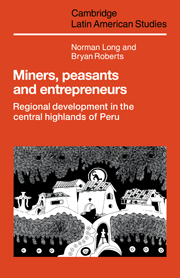Book contents
- Frontmatter
- Contents
- List of tables
- List of figures
- List of maps
- Preface
- 1 Regional development in an export economy
- 2 The development of a regional economy in the central highlands
- 3 The Mining Corporation and regional development
- 4 Class relations, local economies and large-scale mining
- 5 Highland puna communities and the impact of the mining economy
- 6 Migration and social differentiation amongst Mantaro valley peasants
- 7 Industrialization and the emergence of an informal regional economy
- 8 The village economy, agricultural development and contemporary patterns of social differentiation
- 9 Regional commitment among central highlands migrants in Lima
- 10 Confederations of households: extended domestic enterprises in city and country
- 11 Regional development in peripheral economies
- Notes
- Bibliography
- Index
- Titles in the series
4 - Class relations, local economies and large-scale mining
Published online by Cambridge University Press: 07 May 2010
- Frontmatter
- Contents
- List of tables
- List of figures
- List of maps
- Preface
- 1 Regional development in an export economy
- 2 The development of a regional economy in the central highlands
- 3 The Mining Corporation and regional development
- 4 Class relations, local economies and large-scale mining
- 5 Highland puna communities and the impact of the mining economy
- 6 Migration and social differentiation amongst Mantaro valley peasants
- 7 Industrialization and the emergence of an informal regional economy
- 8 The village economy, agricultural development and contemporary patterns of social differentiation
- 9 Regional commitment among central highlands migrants in Lima
- 10 Confederations of households: extended domestic enterprises in city and country
- 11 Regional development in peripheral economies
- Notes
- Bibliography
- Index
- Titles in the series
Summary
In this and the next two chapters, we look at the implications of the dominance of the mining economy for the class relations that developed in different types of rural and urban location. The expansion of mining created opportunities and constraints and stimulated a diversity of responses from a highly differentiated peasant sector which was closely interrelated with local towns and cities. The struggles that took place focussed on the appropriation and control of the new resources generated by the mining economy.
The cases that follow have been chosen to illustrate this complexity, contrasting the impact of the mining economy on economically differentiated, agriculturally based villages in the valley with its impact on less differentiated, predominantly pastoral villages in the highland zone. The valley villages have a history of ‘independent’ smallholder production, complemented by crafts and commerce; whereas the livelihood of the highland puna villages has been more dependent on external factors, such as relations with the owners of the large livestock estates bordering them and with the valley merchants and farmers.
In the present chapter, we focus upon Huancayo, the administrative and service centre of the central highlands. Huancayo illustrates, more than any other location in the region, the workings of the mining system of production since it is the place through which a great deal of the inputs and outputs of the mining sector are organized. We analyse the class composition of Huancayo at the height of the dominance of the mining economy. By this time, Huancayo had become the main centre of the central highlands and was the place of residence of a regionally important class of businessmen.
- Type
- Chapter
- Information
- Miners, Peasants and EntrepreneursRegional Development in the Central Highlands of Peru, pp. 70 - 87Publisher: Cambridge University PressPrint publication year: 1984



